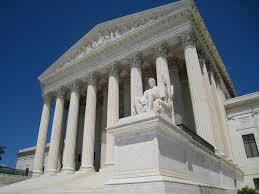U.S. Supreme Court wrestles with major Alabama voting rights fight
The U.S. Supreme Court heard spirited arguments on Tuesday in a major legal battle that threatens to further undermine a landmark federal voting rights law as the state of Alabama defends a Republican-drawn electoral map faulted by judges for diluting the clout of Black voters.

- Country:
- United States
The U.S. Supreme Court heard spirited arguments on Tuesday in a major legal battle that threatens to further undermine a landmark federal voting rights law as the state of Alabama defends a Republican-drawn electoral map faulted by judges for diluting the clout of Black voters. Alabama Solicitor General Edmund LaCour faced tough questioning from the court's three liberal justices - Ketanji Brown Jackson, Elena Kagan and Sonia Sotomayor - as he defended the Republican-drawn map delineating the boundaries of Alabama's seven U.S. House of Representatives districts.
A three-judge federal court panel invalidated the map after it was challenged as unlawful by Black voters. But the Supreme Court, in a 5-4 decision in February, let Alabama use the map for the Nov. 8 U.S. congressional elections in which Republicans are trying to regain control of Congress. The dispute gives the court, with its 6-3 conservative majority, a chance to further roll back protections contained in the 1965 Voting Rights Act, which prohibits racial discrimination in voting.
"What strikes me about this case is that under our precedent it's kind of a slam dunk" against Alabama's map, Kagan said during the arguments that lasted roughly two hours. The lower court found that Alabama's map diminished the influence of Black voters by concentrating their voting power into a single House district even though the state's population is 27% Black, while distributing the rest of the Black population in other districts at levels too small to form a majority.
LaCour told the justices that Alabama's legislature drew the map "in a lawful race neutral manner." "The state largely retained its existing districts and made changes needed to equalize population. But that wasn't good enough for the plaintiffs. They argued that Section 2 of the Voting Rights Act requires Alabama to replace its map with a racially gerrymandered plan maximizing the number of majority-minority districts," LaCour said.
The Voting Rights Act was enacted at a time when Southern states including Alabama enforced policies blocking Black people from casting ballots. The case centers on a Voting Rights Act provision, called Section 2, aimed at countering voting laws that result in racial bias even absent racist intent. Sotomayor questioned LaCour about why the Republican-drawn map split up key Black communities among House districts but not key white communities.
Deuel Ross, a lawyer with the NAACP Legal Defense and Educational Fund representing the plaintiffs, told the justices there was "nothing race-neutral" about the Republican-drawn map. Conservative Justice Amy Coney Barrett said that while proving a map violates Section 2 does not require a showing that state intended to discriminate, a baseline is needed to determine whether a map improperly dilutes Black voters.
"What about equal opportunity? That's my concern," Barrett said. CONSTITUTIONAL RIGHTS
Alabama has argued that drawing a second district to give Black voters a better chance at electing their preferred candidate would itself be racially discriminatory by favoring them at the expense of other voters. If the Voting Rights Act required the state to consider race in such a manner, according to Alabama, the statute would violate the U.S. Constitution's 14th Amendment guarantee of equal protection under the law. Jackson, the first Black woman to serve on the court, during her second day on the bench questioned the Alabama's position that interpreting Section 2 to require Alabama to create another majority-Black district would violate the 14th Amendment, which was ratified in 1868 after the U.S. Civil War to help protect the rights of newly freed Black enslaved people.
Conservative Justice Samuel Alito, during questioning of Ross, asked whether in determining if a map was reasonably configured the court could consider "whether it is the kind of district that an unbiased map maker would draw?" A decision is expected by the end of June.
Conservative Chief Justice John Roberts joined the court's liberals in dissent from the February decision allowing the Alabama map to go into use, but previously has voted to limit the Voting Rights Act's reach. Democratic President Joe Biden's administration backed the plaintiffs.
Conservative states and groups already have successfully prodded the Supreme Court to limit the Voting Rights Act's scope. Its 2013 ruling in another Alabama case struck down a key part that determined which states with histories of racial discrimination needed federal approval to change voting laws. In a 2021 ruling endorsing Republican-backed Arizona voting restrictions, the justices made it harder to prove violations under Section 2. Electoral districts are redrawn each decade to reflect population changes as measured by a national census, last taken in 2020. In most states, such redistricting is done by the party in power, which can lead to map manipulation for partisan gain.
In a major 2019 ruling, the Supreme Court barred federal judges from curbing the practice, known as partisan gerrymandering. That ruling did not preclude court scrutiny of racially discriminatory gerrymandering.
(This story has not been edited by Devdiscourse staff and is auto-generated from a syndicated feed.)
ALSO READ
The Curse of Oak Island Season 11 Episode 22: Can Nolan's Cross Lead to the Templars' Greatest Secrets?
Helicopter rescues Taiwan miners as earthquake injuries cross 1,000
LS polls: Punjab police, BSF strategise to counter drug supply from across Indo-Pak border
Cyclicals drive modest gains across European stocks
Appeal to people to look beyond religion, language, caste; choose wisely and install democratic government: Cong manifesto.










